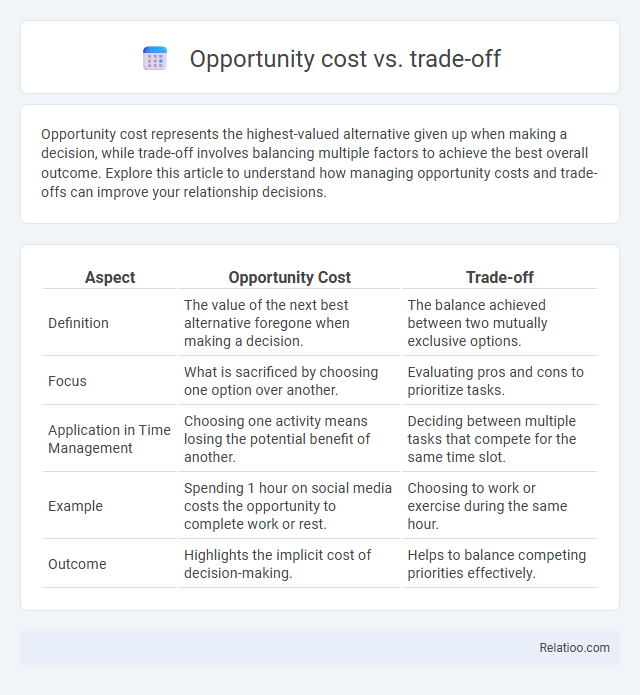Opportunity cost represents the highest-valued alternative given up when making a decision, while trade-off involves balancing multiple factors to achieve the best overall outcome. Explore this article to understand how managing opportunity costs and trade-offs can improve your relationship decisions.
Table of Comparison
| Aspect | Opportunity Cost | Trade-off |
|---|---|---|
| Definition | The value of the next best alternative foregone when making a decision. | The balance achieved between two mutually exclusive options. |
| Focus | What is sacrificed by choosing one option over another. | Evaluating pros and cons to prioritize tasks. |
| Application in Time Management | Choosing one activity means losing the potential benefit of another. | Deciding between multiple tasks that compete for the same time slot. |
| Example | Spending 1 hour on social media costs the opportunity to complete work or rest. | Choosing to work or exercise during the same hour. |
| Outcome | Highlights the implicit cost of decision-making. | Helps to balance competing priorities effectively. |
Introduction to Opportunity Cost and Trade-Off
Opportunity cost represents the value of the next best alternative foregone when making a decision, highlighting the real cost of choices in economic terms. Trade-off involves balancing between two or more desirable but incompatible options, emphasizing the need to sacrifice one benefit to gain another. Understanding opportunity cost is essential for evaluating trade-offs, as it quantifies what is lost in favor of a selected option, aiding effective decision-making in resource allocation.
Defining Opportunity Cost: What You Give Up
Opportunity cost refers to the value of the next best alternative foregone when a decision is made, highlighting what you give up to pursue a particular option. Trade-off involves choosing between two or more alternatives, where gaining one option results in losing others, emphasizing the balance between different benefits and sacrifices. Understanding opportunity cost clarifies the true cost of any choice by quantifying the potential benefits missed from unused alternatives.
Understanding Trade-Off: Making Choices
Understanding trade-offs involves recognizing that choosing one option requires sacrificing another, highlighting the inherent scarcity of resources. Opportunity cost quantifies the value of the next best alternative forgone when a decision is made, serving as a fundamental concept in evaluating trade-offs. Effective decision-making demands assessing these opportunity costs to optimize resource allocation and achieve desired outcomes.
Key Differences Between Opportunity Cost and Trade-Off
Opportunity cost refers to the value of the next best alternative foregone when a decision is made, emphasizing the quantifiable loss involved. Trade-off involves balancing multiple factors or choices, highlighting the necessity to sacrifice one aspect to gain another without always specifying a measurable cost. The key difference lies in opportunity cost quantifying what is sacrificed explicitly, whereas trade-offs describe the broader process of making compromises between competing options.
Examples of Opportunity Cost in Daily Life
Opportunity cost represents the value of the next best alternative you give up when making a decision, such as choosing to spend time studying instead of working a part-time job. Trade-offs involve balancing multiple factors, like deciding between saving money or spending it on leisure activities, each with its own opportunity costs. In daily life, examples of opportunity cost include the lost income from taking a vacation instead of working or the potential benefit you forego by purchasing one expensive gadget instead of investing those funds.
Trade-Offs in Decision Making: Practical Scenarios
Trade-offs in decision making involve balancing different factors where choosing one option requires sacrificing another, highlighting the need to prioritize based on your goals and resources. In practical scenarios, such as budgeting time for work versus leisure or allocating limited funds between projects, understanding trade-offs ensures informed choices that maximize value. While opportunity cost quantifies the value of the next best alternative forgone, trade-offs emphasize the balancing act between competing demands, guiding effective decision-making strategies.
The Role of Scarcity in Opportunity Cost and Trade-Off
Scarcity forces individuals and businesses to make decisions where opportunity cost reflects the value of the next best alternative foregone when choosing one option over another. Trade-offs represent the balancing act between competing desires or needs, illustrating the direct consequence of scarce resources requiring choices between alternatives. Understanding scarcity's role highlights why opportunity cost and trade-offs are fundamental concepts in economic decision-making, guiding resource allocation to maximize value under limited availability.
Why Opportunity Cost Matters in Economic Choices
Opportunity cost represents the value of the next best alternative forgone when making an economic decision, highlighting what You sacrifice in terms of time, money, or resources. Trade-offs involve balancing different factors or choices, which underlines the necessity of evaluating opportunity costs to optimize Your decisions. Understanding opportunity cost matters because it enables individuals and businesses to allocate scarce resources efficiently, maximizing benefits and minimizing regrets in economic choices.
Assessing Trade-Offs for Better Decision Outcomes
Assessing trade-offs involves evaluating the benefits and drawbacks of different choices to make informed decisions that align with your goals. Opportunity cost quantifies the value of the next best alternative foregone when selecting one option over another, highlighting the true expense of decisions. Understanding opportunity cost and trade-offs enables you to optimize resource allocation and improve decision outcomes in business, finance, and daily life.
Conclusion: Maximizing Value Through Smarter Choices
Maximizing value through smarter choices involves understanding that opportunity cost quantifies the true cost of forgone alternatives, while trade-offs represent the necessity of balancing competing options. Recognizing opportunity cost helps you evaluate the potential benefits lost when selecting one option over another, enabling more informed decisions. By integrating both concepts, you optimize resource allocation and ultimately enhance overall value.

Infographic: Opportunity cost vs Trade-off
 relatioo.com
relatioo.com